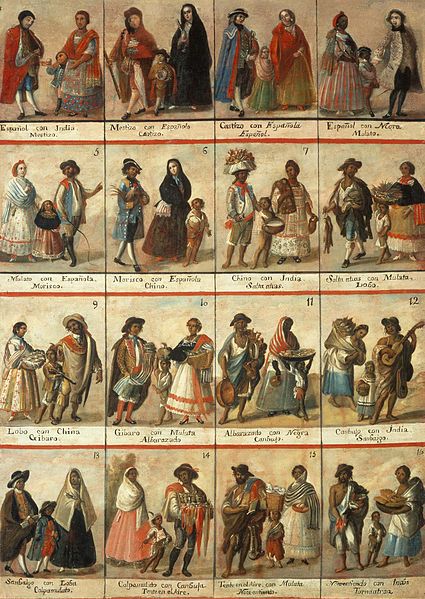The 2020 U.S. census shows that the Hispanic population decreased from 81.6% in 2010 to less than 57.8% in 2020. This statistic may seem confusing, as Mexican immigrants are the largest group of U.S. immigrants, and the United States is known for having a large Hispanic population. However, the 2020 census also reported that over one-third of the Hispanic population reported two or more races. For comparison, in 2010, 2.6 million Hispanic people reported being multiracial, compared to 18.6 million people in 2020.
Defining Hispanic identity is not a contemporary issue — putting racial and ethnic labels on different identities has been ongoing for centuries. In the 15th century, when Spanish colonizers first arrived in present-day Mexico, they created a system of social classes known as the caste system. The system designated a person’s race with their economic status. Essentially, the more Spanish blood a person had, the higher they ranked in the system. The famous painting “Las Castas” depicts sixteen different caste combinations and labels.
As far back as at least the 15th century, Hispanic people have been judged and evaluated based on how white they are. Whether it’s official documentation or everyday interactions, it feels impossible to escape these classifications. As someone who considers herself a mixed Hispanic (my dad is from Mexico, and my mom is a white American), it feels like everywhere I go and in every first interaction, people are trying to figure out how white I am. Sometimes, it feels as if someone is pulling up an imaginary “Las Castas” painting to my face to determine which classification I fall into.
The truth is, most mixed people don’t really know their ethnic or racial make-up. When people ask my ethnicity, my most common response is, “I am half white and half Mexican;” but, the reality is much harder to explain and goes beyond percentages and fractions.
The Hispanic identity is historically a mixed one. Because there were interracial marriages and relationships during the colonial period, the populations of most Hispanic countries have mixed identities to begin with. As time goes on, it becomes harder and harder to separate and put labels on identities clearly. Being Hispanic is not homogenous, and we need to stop acting like it is.
Furthermore, an emphasis on defining race often plays into ideas of colorism and racism in these communities. A new Pew Research Study states that Hispanics of darker skin reported less access to opportunities and more discrimination compared to those with a lighter complexion. It is important to remember that not every Hispanic person’s experience is the same and most harbor multiple identities. The Hispanic identity is in and of itself an intersection of many experiences and identities.
On the other hand, as a mixed Hispanic, I am often called “white-washed” or accused of not being a “real Mexican.” While it is important to point out whitewashing in film and television, for example when characters of color are replaced with white characters, sometimes the term can be used to invalidate someone else’s identity. Although preserving our culture and celebrating our heritage is critical, sometimes I wonder if terms like “white-washed” should be used more carefully. Who gets to decide who is a “real Mexican?” Identity is a deeply personal topic and varies from person to person.
I grew up listening to Latin music and making tortillas for dinner, but I never learned Spanish fluently and have never stepped foot in Mexico. Even though I identify as a Hispanic woman, I know some people would disagree with me. I also know that other people may identify as the exact same thing but look and have different experiences than I do.
So where exactly do we draw the line between who gets to be Hispanic and what makes someone whitewashed? If I learned more Spanish as a kid, would that change the box I mark on the U.S. census? If I took a DNA test and it turned out to be 49% Mexican, would I still be Hispanic?
When identity is defined by race, what languages you can speak, etc., it delegitimizes people’s experiences. Since identity is so personal, finding a definition that incorporates everyone’s nuances becomes harder and harder. It puts unnecessary emphasis on somewhat subjective elements.
At a glance, the 2020 U.S. census shows that the Hispanic population is shrinking. However, in reality, the demographic is getting more diverse and more mixed. The population, in this way, is actually growing. Instead of viewing the increased numbers of mixed-raced Hispanics as a dilution of culture and heritage, it may be more useful to understand these numbers as a marker of diversity.
The Hispanic population is a heterogeneous one, comprised of different, unique individuals. In order to understand the Hispanic population, it is crucial to understand all of its nuances and diversities. I identify as a mixed Hispanic woman. These two classifications are not contradictory, rather, being Hispanic means being diverse.
It means celebrating Hispanic heritage in all its forms, colors and differences.







